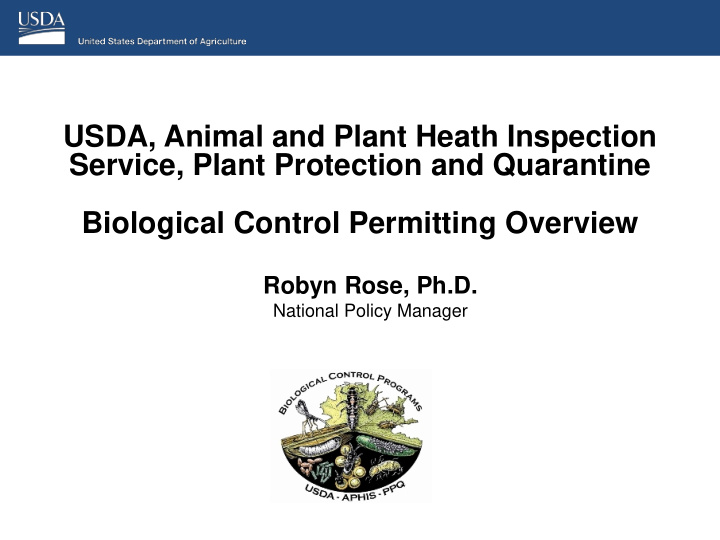



USDA, Animal and Plant Heath Inspection Service, Plant Protection and Quarantine Biological Control Permitting Overview Robyn Rose, Ph.D. National Policy Manager
Animal and Plant Health Inspection Service (APHIS) • Plant Protection and Quarantine (PPQ) – Safeguards agriculture and natural resources from risks associated with the entry, establishment, or spread of pests and noxious weeds. • Plant Pest – The term ‘‘plant pest’’ means any living stage of a pest that can directly or indirectly injure, cause damage to, or cause disease in any plant or plant product.
Biological Control • Any enemy, antagonist, or competitor used to control a plant pest or noxious weed. • Common examples include: • parasites and predators of plant pests; • pathogens of plant pests; • herbivores used against noxious weeds; • microorganisms which kill plant pathogens or prevent infection of the host plants.
prioritize & select targets Initiation Collect, colonize, screen “Foreign exploration” Research in U.S. quarantine, foreign partners (CABI), country of origin Confirm ID and strain/colony purity Host specificity testing non-target/environmental Pre-release R&D: impacts geographical range most of the costs Assemble release petition monitoring plan much of the time Endangered Species Act Environmental compliance National Environmental Policy Act & Tribal Outreach develop agent release protocols Implementation : Initial field releases establishment and establishment putting agents in the field monitoring methods incl. non-target impacts mass-rearing technology Distribution, monitoring Release site criteria and protocols and evaluation Develop and facilitate Technology transfer partnerships 10-20 years
Implementation Timeline • How Long? – Difficult to Answer – Recovery: 2-3 years or more – Establish: 5-10 years or more – Maintain Field Insectaries: 3-5 years – Regional Distribution: 3-5 years – Self-Sustaining Population
Factors to Determine PPQ Interest and Need • PPQ priorities • State interest • Pest impact • Exotic/Introduced pest • Impending risk of invasion • Pests impacting Threatened/Endangered Species • Lack of effective/feasible alternatives • Multi-state established pest • Emergency response needs
Project Prioritization Factors • Importance of pest (e.g. emergency, impacts) • Amount of resources needed (time and money) • Opportunities (e.g. timing, agents, partnerships) • Likelihood of success (e.g. measurable, agent establishment and impact)
Foreign Exploration
Permits for Biological Control Organisms APHIS requires researchers to have PPQ 526 permits for the: • Importation • Interstate movement • Movement between containment facilities • Continued permits for containment facilities • Releases into the environment
Permits for Importation • Required for • all biological control organisms • EPA registered biopesticides • Containment facility • must be inspected • Some, “commercial” biological control organisms, that are native or widely established, have few permit restrictions after importation.
Interstate Movement Permits • Required when: • researchers move non-native organisms between states for release • release or research occurs outside a containment facility • native organisms are moved into states where they are not established
Environmental Release Permits • Ecological risk analyses • Host specificity testing • Environmental compliance
Environmental Compliance for New Release Permits • Review the petition • Consult with NAPPO (North American Plant Protection Organization) • Endangered Species Act (ESA) • Biological Assessment (BA) • U.S. Fish and Wildlife Service (FWS) • National Environmental Policy Act (NEPA) documents. • Environmental Assessment (EA) • Environmental Impact Statement (EIS) • Categorical Exclusion (CatEx) • Tribal consultation
BA/BE Preparation in Accordance with ESA • 3 parts • Species accounts for all listed endangered, threatened, proposed, and candidate species that might be affected by the proposed action • Current status of the listed species and critical habitat designation • Effects assessment • Determinerniation • No effect • May affect, but is not likely to adversely affect • May affect, and is likely to adversely affect. • Go to the threatened and endangered species system http://ecos.fws.gov/tess_public/
EA Preparation in Accordance with NEPA • Four parts to an EA 1. Purpose and need for the proposed action 2. Alternatives including the proposed action 3. Affected environment and environmental consequences 4. List of preparers • EA must address whole continental US • Cumulative effects • 4-Point Memo Public communication o Public controversy o EIS for permitting regulations o • Notice of Availability published in Federal Register to allow PUBLIC comment. • Response to comments Final EA and Finding of No Significant Impact (FONSI)
Funding • PPQ Biological Control Line Item • Farm Bill Section 10007
Acknowledgements Ron Weeks, APHIS PPQ Science and Technology Keith Colpetzer, APHIS PPQ Field Operations Bob Pfannanstiel, APHIS PPQ Permitting Tracy Willard, APHIS PPD, Environmental and Risk Analysis Kai Caraher, APHIS PPQ Environmental Compliance
Thank You! Questions?
Recommend
More recommend